_
|
PERSONNEL |
|
|
|
BRIGADIER GENERAL DUANE W. DEAL |
|
|
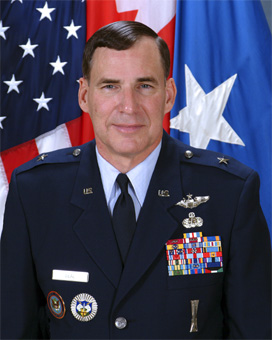 |
|
|
F-106 PILOT
Quality Assurance Officer
Job
Control Officer
Interim Detachment Commander
(198? - 1983) |
|
|
|
|
|
BIOGRAPHY |
|
|
|
|
|
Brig. Gen. Duane
W. Deal entered the Air Force in 1976 as a distinguished graduate of the
Air Force ROTC program. He has served as a senior pilot with more than
2,200 flying hours in seven aircraft types, including the SR-71
Blackbird in which he flew worldwide operational missions. The general
served as a logistics officer commanding three maintenance squadrons,
one of which won "Best in the Air Force" honors, and one squadron in the
Persian Gulf theater. He also served as Deputy Commander for Logistics
for a provisional wing operating from a forward-deployed location
providing support for the Persian Gulf theater in the first Gulf War.
|
|
|
|
General Deal has
commanded a space operations squadron, a logistics group, and three Air
Force wings. Under his tenure, the 21st Space Wing was named the best
wing in the Air Force Space Command. Having been a president or member
of a dozen aircraft and space launch accident investigations, he served
as a member of the Columbia Accident Investigation Board, convened hours
after the loss of the space shuttle on Feb. 1, 2003. The general has
more than 25 published articles on aviation, leadership and technical
subjects.
|
|
|
|
General Deal's
last assignment was Commander, Cheyenne Mountain Operations Center,
Cheyenne Mountain Air Station, Colo. He is responsible for executing the
North American Aerospace Defense Command's integrated tactical warning
and attack assessment mission, the U.S. Northern Command's homeland
defense mission, and U.S. Strategic Command's space and missile warning
support.
|
|
|
|
He retired from
the Air Force on 01 September 2005.
|
|
|
|
|
|
|
|
EDUCATION |
|
|
|
|
|
1975 Bachelor of
Science degree in physics, with distinction, Mississippi State
University
|
|
|
|
1976 Master of
Science degree in counseling and psychology, highest distinction,
Mississippi State University
|
|
|
|
1976 Squadron
Officer School, by correspondence
|
|
|
|
1979 Master of
Science degree in systems management, summa cum laude, University of
Southern California
|
|
|
|
1982 Marine Corps
Command and Staff College, by correspondence
|
|
|
|
1988 National
Security Management Course, by correspondence
|
|
|
|
1989
Distinguished graduate, Air Command and Staff College, Maxwell AFB, Ala.
|
|
|
|
1992 RAND
Research Fellowship, Santa Monica, Calif.
|
|
|
|
1992 Outstanding
graduate, Air War College, by seminar
|
|
|
|
1995 National
Defense Fellow, Center for International Affairs, Harvard University,
Cambridge, Mass.
|
|
|
|
1999 Tuck
Executive Program, Dartmouth College, Hanover, N.H.
|
|
|
|
2004 Program for
Senior Executives in National and International Security, John F.
Kennedy School of Government, Harvard University, Boston, Mass.
|
|
|
|
|
|
ASSIGNMENTS |
|
|
|
1. May 1976 - April 1977, student, undergraduate pilot
training, Columbus AFB, Miss.
|
|
|
|
2. April 1977 - October 1979, B-57, EB-57 and T-33 pilot,
assistant quality control officer and aide-de-camp to the 24th North
American Aerospace Defense Region Commander, Malmstrom AFB, Mont.
|
|
|
|
3. October 1979 - October 1982, quality assurance officer,
job control officer and interim detachment commander, McChord AFB,
Wash., and F-106 and T-33 pilot, Tyndall AFB, Fla., and McChord AFB
|
|
|
|
4. October 1982 - November 1983, logistics programs
monitor, Air Staff Training Program, Directorate of Maintenance and
Supply, Headquarters U.S. Air Force, Washington, D.C.
|
|
|
|
5. November 1983 - June 1986, SR-71 and T-38 pilot, 4029th
Strategic Reconnaissance Training Squadron, later, 1st Strategic
Reconnaissance Squadron, Beale AFB, Calif.
|
|
|
|
6. June 1986 - May 1987, executive and protocol officer,
9th Strategic Reconnaissance Wing, Beale AFB, Calif.
|
|
|
|
7. May 1987 - July 1988, Commander, 9th Avionics
Maintenance Squadron, Beale AFB, Calif.
|
|
|
|
8. July 1988 - July 1989, student, Air Command and Staff
College, Maxwell AFB, Ala.
|
|
|
|
9. July 1989 - August 1991, Commander, 319th Field
Maintenance Squadron, Grand Forks AFB, N.D. (October 1990 - January
1991, Commander, 1706th Consolidated Aircraft Maintenance Squadron, and
Deputy Commander for Logistics, 1706th Air Refueling Wing (Provisional),
Persian Gulf)
|
|
|
|
10. August 1991 - July 1992, Air Force Research Fellow,
RAND Corp., Santa Monica, Calif.
|
|
|
|
11. July 1992 - July 1994, Director, Command Action Group,
Air Training Command, later, Air Education and Training Command,
Randolph AFB, Texas
|
|
|
|
12. July 1994 - July 1995, National Defense Fellow, Center
for International Affairs, Harvard University, Cambridge, Mass.
|
|
|
|
13. July 1995 - May 1996,
Commander, 2nd Space Warning Squadron, Buckley ANGB, Colo.
|
|
|
|
14. June 1996 - January 1998, Commander, 21st Logistics
Group, Peterson AFB, Colo.
|
|
|
|
15. January 1998 - May 2000, Commander, 11th Wing, Bolling
AFB, Washington, D.C.
|
|
|
|
16. May 2000 - May 2002, Commander, Air Force Recruiting
Service, Headquarters AETC, Randolph AFB, Texas
|
|
|
|
17. May 2002 - March 2004, Commander, 21st Space Wing,
Peterson AFB, Colo.
|
|
|
|
18. March 2004 - Sept 2005, Commander, Cheyenne Mountain
Operations Center, Cheyenne Mountain Air Station, Colo.
|
|
|
|
|
|
BADGES |
|
|
|
Senior Pilot Badge
Parachutist Badge
Master Space
Operations Badge
Master Maintenance and Munitions Badge
Missile
Maintenance Badge
|
|
|
|
|
|
MAJOR AWARDS AND DECORATIONS |
|
|
|
Defense Superior Service Medal
Legion of Merit with two
oak leaf clusters
Meritorious Service Medal with three oak leaf
clusters
Air Medal with oak leaf cluster
Combat Readiness Medal
Air Force Recognition Ribbon
Southwest Asia Service Medal with bronze
star
Humanitarian Service Medal
Military Outstanding Volunteer
Service Medal
|
|
|
|
|
|
OTHER ACHIEVEMENTS |
|
|
|
1989 Wright Brothers Squadron Officership Award, Air
Command and Staff College
1990 Air Force Maintenance Effectiveness
Award
1995 and 1996 General Seth J. McKee Award
1996 "Top Gun"
Space Operations Unit winner, Guardian Challenge '96, Air Force Space
Command
1997 and 1998 General Thomas Gerrity Award, AFSPC
1999
Will Tubbs Trophy for "Best Ground Safety Program in the Air Force"
1999 and 2000 Secretary of the Air Force Safety Award
2001 Ground
Safety Award, Air Education and Training Command
2001 Verne Orr
Award, AETC
2003 General Robert T. Herres Award, Air Force Space
Command
2003 NASA Group Achievement Award for Columbia Accident
Investigation Board
2004 General Thomas D. White Space Trophy, Air
Force Association
2005 NASA Exceptional Service Medal
|
|
|
|
|
|
OPERATIONAL INFORMATION |
|
|
|
Weapons systems: B-57, EB-57, AT-33, F-101, F-106, T-38,
SR-71
Defense Support Program Satellite Crew Commander, Space Control
Center Crew Commander, and Cheyenne Mountain Operations Center Command
Director
|
|
|
|
|
|
EFFECTIVE DATES OF PROMOTION |
|
|
|
Second Lieutenant April 13, 1976
First Lieutenant Dec.
4, 1977
Captain Dec. 4, 1979
Major Feb. 1, 1987
Lieutenant
Colonel July 1, 1991
Colonel Feb. 1, 1995
Brigadier General Aug.
1, 2001
|
|
|
|
Current as of July 2005 |
|
|
|
|
|
DET-1 318 FIS COMMANDER |
|
|
 |
|
|
|
Gathering ADDITIONAL Information - Please email:
greendragonsden@yahoo.com |
|
|
|
|
|
|
|
|
|
Columbia Accident Investigation
Board |
|
|
%20BoardPortrait%20550X246.jpg) |
|
X |
|
The 13 member
Columbia Accident Investigation Board poses for a group photo taken in
the CAIB boardroom. The official STS-107 portrait hangs on the wall in
the center of the boardroom. From left to right seated are board members
Roger E. Tetrault, Dr. James N. Hallock, Board Chairman Admiral
(retired) Hal Gehman, Dr. Sheila Widnall, Dr. Douglas D. Osheroff.
Standing from left to right are: Rear Admiral Stephen Turcotte, Brig.
General Duane Deal, Maj. General Kenneth W. Hess, Dr. Sally Ride, Steven
Wallace, Dr. John Logsdon, Maj. General John Barry, and G. Scott
Hubbard.
|
|
|
|
|
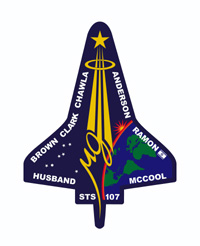 |
|
|
|
|
%20Board-6%20550X442.jpg) |
|
x |
|
The CAIB was
represented by (left to right) CAIB PAO who facilitated the press
briefing, CAIB Chairman Hal Gehman, Brig. General Duane Deal, Maj.
General Kenneth W. Hess, and Dr. Sheila Widnall at a press briefing at
the Lunar & Planetary Institute in Houston TX on May 28, 2003. CAIB
Photo by Rick Stiles 2003
|
|
|
|
|
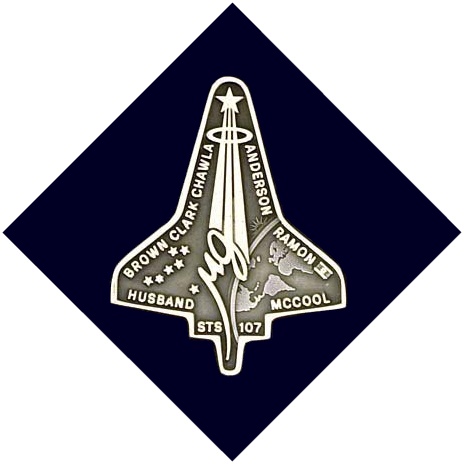 |
|
|
|
|
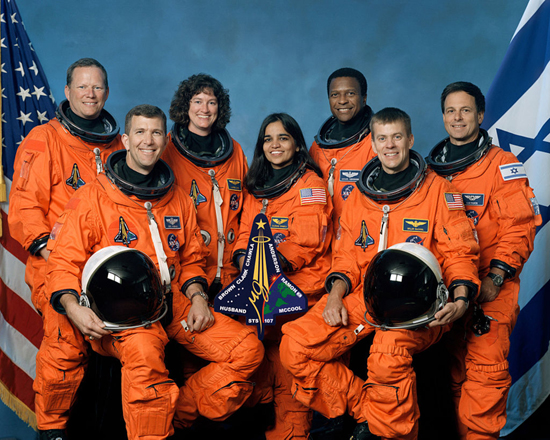 |
|
|
|
The seven STS-107
crew members take a break from their training regimen to pose for the
traditional crew portrait. Seated in front are astronauts Rick D.
Husband (left), mission commander; Kalpana Chawla, mission specialist;
and William C. McCool, pilot. Standing are (from the left) astronauts
David M. Brown, Laurel B. Clark, and Michael P. Anderson, all mission
specialists; and Ilan Ramon, payload specialist representing the Israeli
Space Agency.
|
|
|
|
|
|
|
|
STS-107
was the 113th flight of the Space Shuttle program, and the disastrous
final flight of Space Shuttle Columbia. The mission launched from
Kennedy Space Center in Florida on 16 January 2003, and during its 16
days in orbit conducted a multitude of international scientific
experiments. The seven-member crew was killed on 1 February when
Columbia disintegrated during reentry into the atmosphere.
|
|
|
|
The
Columbia Accident
Investigation Board (CAIB) was convened by NASA to investigate the
destruction of the Space Shuttle Columbia during STS-107 upon
atmospheric re-entry on February 1, 2003. The panel determined that the
accident was caused by foam insulation breaking off from the shuttle,
forming debris which damaged the wing; and that the problem of "debris
shedding" was well known but considered "acceptable" by management. The
panel also recommended changes that should be made to increase the
safety of future shuttle flights. The CAIB released its final report on
August 26, 2003.
|
|
|
|
|
|
Major
findings
|
|
|
|
The board found
both the immediate physical cause of the accident and also what it
called organizational causes.
|
|
|
|
82 seconds
after launch a large piece of foam insulating material, the "left bipod
foam ramp", broke free from the external tank and struck the leading
edge of the shuttle's left wing, damaging the protective carbon heat
shielding panels.
|
|
|
|
During re-entry
into the Earth's atmosphere, this damage allowed super-heated gases to
enter and erode the inner wing structure which led to the destruction of
Columbia. It was the seventh known instance of piece of foam,
from this particular area of the external tank, breaking free during
launch.
|
|
|
|
|
|
Organizational
cause of the accident
|
|
|
|
The problem of
debris shedding from the external tank was well known and had caused
shuttle damage on every prior shuttle flight. The damage was usually,
but not always, minor. Over time, management gained confidence that it
was an acceptable risk. NASA decided that it did not warrant an extra
EVA for visual inspection, feeling that it would be like a car going
down a highway and hitting a Styrofoam cooler.
|
|
|
|
|
|
Board
recommendations
|
|
|
|
The board made
29 specific recommendations to NASA to improve the safety of future
shuttle flights. These recommendations include:
|
|
|
|
- Foam from
external tank should not break free
- Better
pre-flight inspection routines
- Increase
quality of images available of shuttle during ascent and on-flight
- Recertify
all shuttle components by the year 2010
- Establish
an independent Technical Engineering Authority that is responsible
for technical requirements and all waivers to them, and will build a
disciplined, systematic approach to identifying, analyzing, and
controlling hazards throughout the life cycle of the Shuttle System.
|
|
|
|
|
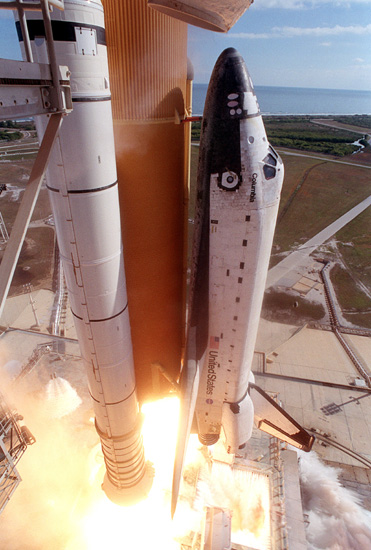 |
|
|
|
|
|
|
 |
|